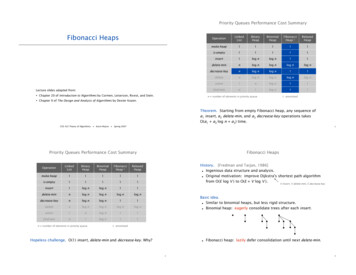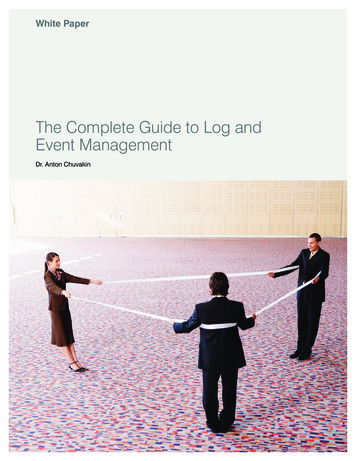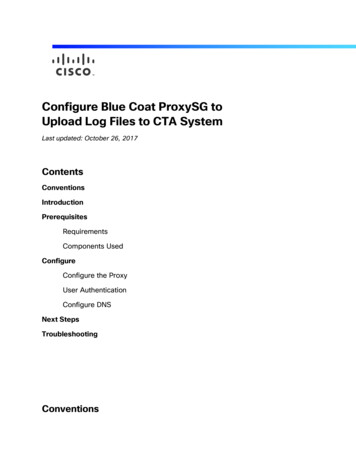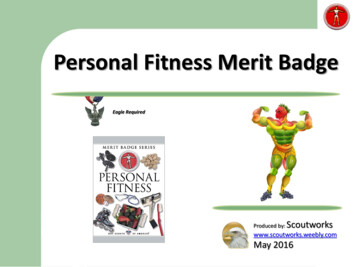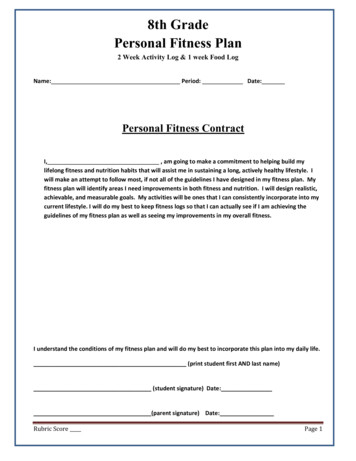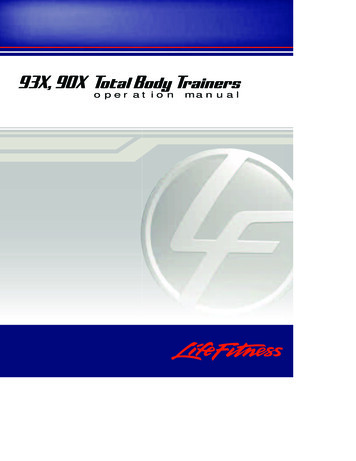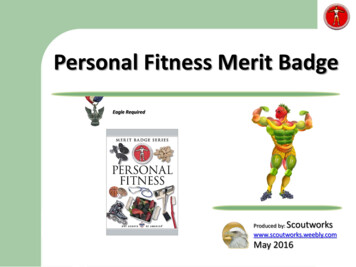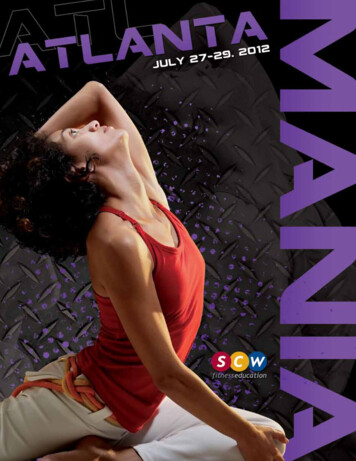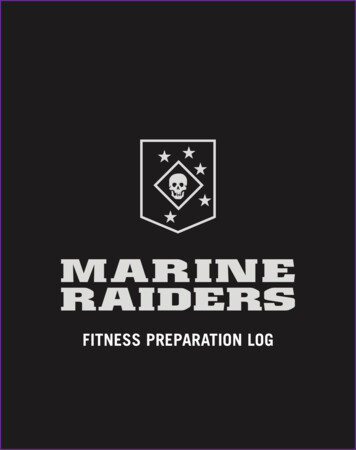
Transcription
FITNESS PREPARATION LOG
I N T R O D U C T I O NThe Marine Corps Forces Special Operations Command (MARSOC)is preparing professional combat athletes who are ready to executemissions in the largely unstructured battlefields of today and thefuture. MARSOC’s performance and resilience ideology—whichfocuses on mind, body, and spirit—is integral to preparation andsuccess.MARSOC seeks to ensure that Marines are not only physically strongbut also possess the mental focus and unconquerable spirit necessaryto persevere under the extreme stress of a high operational tempo andthrough the unknowns of asymmetric warfare. Critical skills operatorsare trained with renewal in mind, focusing on the resilience of theindividual, unit, and family.This fitness program focuses on improving physical performance throughexercise and nutrition. It provides photographs and descriptions ofexercises used at MARSOC, and is designed to prepare candidatesfor the physical aspects of Assessment and Selection (A&S). Uponarriving at A&S, candidates are expected to have completed this 10week program.
The Three PillarsIn addition to preparing candidates for the rigors of Phases I and II ofA&S, this 10-week program prepares candidates for the following threefitness tests:The MARSOC In TestThe United States Marine Corps ModifiedIntermediate Level Swim TestThe United States Marine Corps Special Operations CommandAssessment & Selection Ruck Movement StandardsThe schedule is developed to give each event–running, swimming, andrucking–at least two training days a week.Some workout days have MARSOC In Test preparation sections thatare meant specifically to address pull-ups or crunches. Ruck workoutson Tuesdays incorporate exercises that will help you increase your speedwith a ruck, as well as develop your ability to carry it during hard andphysically demanding movements.The fitness program outlines the maximum amount of daily events to beconducted. Individuals should strive to complete all of the daily eventsfor the best results possible. Individual training goals should take intoconsideration levels of fitness in each of the core areas and focus onareas of weakness while increasing overall strength.
C O N T E N T SMovement PreparationA warm-up that prepares your body for movement, training, andperformance. It boosts your heart rate, increases blood flow tothe muscles, and elevates your core temperature.Ankles-Hips-ShouldersHip BridgeElbow Push-UpsBird DogFrog SquatsWorld’s Greatest StretchInchworm6667778Walking High KneesWalking Quads PullsCradlesBackwards HamstringHigh KneesButt KicksMovement Prep Card88999911CalisthenicsExercises designed to develop muscular tone and promotephysical well-being, relying heavily on body weight with minimalequipment requirements.Forward PlankSide PlankFlutter KicksPush-UpsLunges with Counter RotationFrog SquatsAmmo Can (or Dumbbell)Push PressAmmo Can (or Dumbbell)ThrusterAmmo Can (or Dumbbell)Front SquatsAir SquatsBurpeesSkatersDumbbell Get-UpsSandbag Get-Ups1212121313131414151515161617Tire Flips20-Meter High CrawlPull-UpsFarmer’s CarryPartner DragsWalking Ammo Can LungeBroad JumpsHand Release Push-upsKnees to ElbowsUSMC CrunchesWalking LungesMountain ClimbersSwimmingTreading WaterRuckingRunningMovement Cards1718181919202021212222222325262930
C O N T E N T SPost-Workout RegenerationActivities that increase the body’s ability to recover faster, inorder to maximize the gains achieved through performancetraining.Active Isolated Stretch (AIS)–Utilize band for the followingCalfHamstringIT BandGroinQuadricepsTriceps424242434343Active Isolated Stretch (AIS)Rotator Cuff44Quadruped Thoracic Spine44Middle Back44RollerCalfHamstringIT BandQuadricepsGroinGluteMiddle and Upper BackLatsHip External RotatorHip FlexorHip AdductorPost-Workout Card454545464646474747484849Nutrition, Hydration, Foot Care, and RecoveryGuidelines that help you select the right foods and beverages foroptimum physical performance.NutritionHydration5050Foot CareRecovery5151
Movement PreparationM O V E M E N TP R E PA R AT I O NAnkles-Hips-ShouldersStarting Position: Left knee bent at 90 degrees, with foot flat on the ground.Right knee is on the ground with foot flexed and arms down at your side.1) Lean forward slightly and raise hands toback of head, with palms facing forward.2) Twist to the left, pause, twist back to thefront.Do 5 reps, then switch legs.Hip BridgeStarting Position: Lying on back with arms away from your sides, with feetflexed.1) Raise your hips off the ground, formingan arch, resting your weight on your shoulderblades (not your neck). Use your hands forbalance. Hold for 15 seconds and return tostarting position.Do 6 reps.Elbow Push-UpsStarting Position: Start in plank position, lying horizontal on forearms, fingersand thumbs together with hands just in front of your face. Feet flexed.1) Push up through your forearms, keepingback straight until your body is off the ground.Pause at the top.2) Keeping back straight, return to startingposition, just above the ground. Do not rest onground.Do 6-8 reps.
7Bird DogStarting Position: Kneeling with palms and knees on the ground, feet flexed;knees directly below hips.1) Lift and extend left arm and right legsimultaneously. Body and extended arms shouldbe parallel to the ground. Hold for 30 seconds.2) Return to starting position.3) Repeat exercise while switching arms andlegs that are extended.Do 5 reps.Frog SquatsStarting Position: Standing with feet more than shoulder width apart.1) Squat as deep as possible with hips backand heels on the ground, hands together at thesame level as your knees.2) Return to starting position.Do 5 reps.World’s Greatest StretchStarting Position: Standing with feet shoulder width apart, hands at yoursides.1) Step forward with yourleft foot, into a lunge position.Bringing your left elbow toyour left knee, reach acrossto grab your right bicep.2) Twist your bodyand rotate up and tothe left, reachingup with your lefthand.3) Bring your hands back down, returningto the lunge position and then back to thestarting position.Do 5 reps, then switch sides.
Movement PreparationM O V E M E N TP R E PA R AT I O NInchwormStarting Position: Face down with arms fully extended and hands and toes onthe ground.1) Slowly walk your legs forwardwhile keeping your hands in place, flaton the ground.2) Go as far as you can with hands on the ground,then return to the starting position.Do 5 reps.Walking High KneesStarting Position: Standing with feet shoulder width apart, hands at your sides.1) Sharply raise left leg level with hips, bending atthe knee so that thigh and foot are parallel with theground, simultaneously pumping right arm.2) Keep back straight and lower left leg and rightarm while raising opposite arm and leg.Do 10 reps.Walking Quads PullsStarting Position: Standing with feet shoulder width apart, hands at your sides.1) Sharply raise lower left leg up and back,stretching quadriceps. Flex foot, bring right armup for balance.2) Keep back straight and lower left leg and rightarm while repeating step one with opposite armand leg.Do 10 reps.
9CradlesStarting Position: Standing with feet shoulder width apart.1) Raise right leg in front of left leg and grasp right calfwith both hands so that calf is parallel to the ground.Hold and balance for 30 seconds.2) Return to starting position.Switch legs and repeat 5 times.Backwards HamstringStarting Position: Standing with feet shoulder width apart, hands at your sides.1) In one movement, bend forward, with both armsforward, and simultaneously bring one leg up, fullyextended.2) Balance on one leg, with foot flat on the ground.Hold for 30 seconds and return to starting position.Repeat on opposite leg. Do 5 reps.High KneesStarting Position: Standing with feet shoulder width apart, hands at your sides.1) Bring the left knee up as high as possible,swinging the right arm up to cheek level.2) Lower leg and repeat with opposite side.Repeat for 15 seconds.Butt KicksStarting Position: Standing with feet shoulder width apart, hands at your sides.1) Standing straight, lift left foot up and back sothat heel touches buttocks.2) Return to starting position and alternate legs.Alternate pumping opposite arms for balance.Repeat for 15 seconds.
Movement PreparationM O V E M E N TP R E PA R AT I O NFor all exercises that begin with one leg, begin with theLEFT LEG FIRST. For most exercises, the instructor countscadence and the student counts the number of reps. Duringsome exercises, the instructor does all of the counting.
1 1MOVEMENT PREP CARDMovement (page #)Reps/time1 Ankles-Hips-Shoulders (6)5 each side (5 count)2 Hip Bridge (6)63 Elbow Push-Ups (6)6-84 Bird Dog (7)5 each side5 Frog Squats (7)56 World’s Greatest Stretch (7)5 each side7 Inchworm (8)58 Walking High Knees (8)10 each side9 Walking Quads (8)10 each side10 Cradles (9)5 each side11 Backwards Hamstring (9)5 each side12 High Knees (9)15 sec13 Butt Kicks (9)15 sec
CalisthenicsC A L I S T H E N I C SForward PlankStarting Position: Lying on stomach, with elbows bent and legs extended,forearms on the ground, and feet flexed.1) Stiffen your core, lifting your body up in onemovement so that you are resting on your forearms andtoes. Your body should be straight.Side PlankStarting Position: On your left side with your body in a straight line (head,shoulder, hip, knees and ankles should be aligned) and forearm underneath you.1) Push up on your left forearm, lifting your righthip, creating a straight line from your shoulder toyour ankle. Only your left foot and left forearmshould remain on the ground. Do not sag or bend atthe waist. To increase difficulty raise your top leg tothe sky.Flutter KicksStarting Position: Lying on back with hands tucked under tailbone.1) Raise your legs together 6-12 inches.2) Alternate moving legs up and down in ascissor motion.
1 3Push-UpsStarting Position: Lying prone with feet flexed, elbows bent and hands undershoulders.1) Push up through your hands, keeping backstraight until elbows are fully extended. Pauseat the top.2) Keeping back straight, return to startingposition, just above the ground. Do not rest onground.Lunges with Counter RotationStarting Position: Standing with feet shoulder width apart, with elbows out tothe side and hands near your ears.1) Step left leg forward into a lunge position,with knee over your toes. Right leg should beback, with knee pointed toward the ground andfoot flexed.2) Rotate your body toward your forward knee,keeping your spine straight.3) Come back to center.4) Drive off the left leg and return to standingposition.Frog SquatsStarting Position: Standing with feet greater than shoulder width apart.1) Squat as deep as possible with hips back andheels on the ground, hands together at the samelevel as your knees.2) Return to starting position.
CalisthenicsC A L I S T H E N I C SAmmo Can Push PressStarting Position: Keeping a neutral neck and flat back, and standing with feetjust wider than shoulder width and toes slightly pointed out, grasp a 30 lb ammocan (or dumbbell) and rest it lightly on top of your upper chest.1) Dip body by bending knees, hips and ankles slightly.2) Explosively drive upward with legs, driving ammo can off chest by vigorously extending armsoverhead.3) Return ammo can to front of upper chest and repeat.Ammo Can ThrusterStarting Position: Keeping a neutral neck and flat back, and standing with feetjust wider than shoulder width and toes slightly pointed out, grasp a 30 lb ammocan (or dumbbell) and rest it lightly on top of your upper chest.1) Descend into a squat by pushing your hips and butt back while inhaling. Continue down until theupper legs are at or just below parallel to the floor.2) Descend into a squat by pushing your hips and butt back. Continue down until the upper legs are ator just below parallel to the floor. Inhale as you perform this portion of the movement.3) Ascend until your arms are fully extended overhead and your legs straight by pushing through yourheels and pressing the ammo can up towards the ceiling. Allow your neck to hyperextend so that theammo can has room to clear your chin.4) Lower the ammo can slowly and transition back into the squatting movement to repeat.
1 5Ammo Can Front SquatsStarting Position: Standing with feet just wider than shoulder width, grasping a30 lb ammo can (or dumbbell) to your chest.1) Squat until the crease of your hip is just below your knee cap.2) Drive back into a standing position with your knees and hips locked out and glutes tight.Air SquatsStarting Position: Standing with feet more than shoulder width apart.1) Squat as deep as possible with hips back and heels on the ground.At the same time, lift both arms to shoulder height.2) Explode from squat position, contracting glutes and return tostarting position.Do 20 reps.BurpeesStarting Position: Standing with feet shoulder width apart.1) Perform a deep squat with hands outfor balance and smooth transition for nextsequence.2) Place hands flat on the ground and explodeback with legs into a push-up position.3) Perform a push-up and return to thestarting position with elbows extended andtoes down.4) Fire your legs in toward your hands, keepingthem on the ground and remaining in the squatposition.5) From the squat position explode up andjump with your hands above your head and legsspread eagle in mid-air.
CalisthenicsC A L I S T H E N I C SSkatersStarting Position: Standing with feet shoulder width apart.1) Shift all your weight onto your right leg,lifting your left foot off the ground. Stabilizeon right leg.2) After a pause, explode off right leg to theleft, landing and stabilizing solely on the leftwhile right leg is off the ground. Pause.3) Explode off left leg, landing and stabilizingon the right while the left is off the ground.Pause and repeat.Dumbbell Get-UpsStarting Position: Lying on back holding a 30 lb dumbbell straight above rightshoulder with arm straight and vertical. Hold left arm out to the side.1) Gripping the dumbbell tightly with your righthand, drive your shoulder toward your left hip,shifting onto your left elbow.5) Shift into a lunge position, then stand up.2) Shift your weight to your left hand and yourright leg.7) Switch the dumbbell to the left side andrepeat the steps on the opposite side.3) Pull your left leg under your hip into akneeling position.4) Shift your weight off of your left hand untilyour torso is upright. The dumbbell shouldbe balanced over the right shoulder and theright arm.6) Reverse the steps to lie back down.
1 7Sandbag Get-UpsStarting Position: Lying on back, with a sandbag on one shoulder.1) Get up any way you can.5) Stand up from the lunge position and bringyour feet underneath your hips. Reverse theprocess to get back down.2) One suggestion is to sit up by moving theloaded shoulder toward the opposite leg.6) Switch the sandbag to the opposite shoulder,and repeat the steps on the opposite side.3) Lean on the elbow of your unloaded arm;keeping your core engaged, shift your weight toyour hand.4) Shift your unloaded hip and knee underneathyour body into a kneeling position. Your loadedside leg should now be in a lunge position.Tire FlipsStarting Position: With the tire lying on its side, stand close (as in a deadlift)with your arms inside your legs, and your legs slightly wider than a normaldeadlift position and grab the underside of the tire.1) Grip the tire solidly; lean in, so your chest is above thetire, and your weight on the balls of your feet.2) Using your legs, begin to stand up while holding thetire firmly.3) Using a pulling motion, pull the tire upright.4) Reverse your grip to a pushing position similar to apush-up or bench press, and push the tire away from youexplosively. Use your legs and hips to give power to thispart of the lift, along with the pushing motion from yourarms and chest.5) Move quickly to the tire, reset your position andcontinue.
CalisthenicsC A L I S T H E N I C S20-Meter High CrawlStarting Position: Hands and knees on ground, with feet flexed and your spineforming a straight line from your head to your tailbone.1) Reach forward with your left handand right knee. Spine should remainstraight.2) Now move forward with right handand left knee.3) Continue for 20 m.Pull-UpsStarting Position: A dead hang with hands greater than shoulder width apart,body relaxed.1) Use both arms and pull your chest up tothe bar, pulling your shoulder blades downand back. Keep core and glutes stiff.2) Actively return to the starting position,pushing chest away from the bar andextending elbows.Every Minute on the Minute (EMOM)Variation: With a continuously runningclock, do one pull-up the first minute,two pull-ups the second minute, threepull-ups the third minute. Continue in thisfashion until you are unable to completethe amount of pull-ups required in a oneminute timeframe. Record the number ofminutes completed.Chin-Ups Variation: reverse grip so palmsface toward you instead of away from you.
19Farmer’s CarryStarting Position: With 50-pound dumbbells (or kettle bells, sandbags, ammocans, etc.) on the ground just outside hip width, stand with good posture andshoulders back, chest out and feet shoulder width apart, similar to standing atattention.1) Keeping your back straight and yourshoulders set, bend at the knees and sitback until you can grip the objects.2) While gripping the objects, stand up,keeping your back straight. Your legs willbe doing all of the work.3) Step forward and walk or run at aquick pace while holding the loads andavoid swaying the loads.Partner DragsStarting Position: Partner A is seated on ground with forearms clasped overeach other and in front of body. Legs are extended. Partner B gets in a dead liftposition behind Partner A, snaking his arms under Partner A’s arms and graspingPartner A’s forearms.1) Partner A remains relaxed, keeping forearmsclasped. Partner B stands up, maintaining astiff core.2) Partner B walks backward, maintainingstraight torso and firm grasp of Partner A’sforearms. Drag for 20 m; then the Partnersswitch positions.
CalisthenicsC A L I S T H E N I C SWalking Ammo Can LungeStarting Position: Holding a 30 lb ammo can (or dumbbell) in each hand.1) Step forward with one leg, and while keeping heel on front leg down and shin relatively vertical,lower yourself until your left thigh is parallel to the floor and your rear knee nearly touches the floor.2) Stand back up by pushing through the heel of your front leg.3) Repeat with opposite leg.Broad JumpsStarting Position: Standing with heels under hips.1) Rapidly squat down several inches withhands in front.2) Explode from the squatting position, andjump as far forward as possible.3) Land softly with your feet under your hips.4) Reset immediately and jump again.
2 1Hand Release Push-upsStarting Position: Front-leaning rest.1) Drop chest to the ground.2) Tighten your upper back and pull your handsoff of the ground.3) Push back into the ground and into thepush-up position.Knees to ElbowsStarting Position: In a dead hang from a pull-up bar with hands greater thanshoulder width apart.1) Keeping your upper back tight and yourshoulders in the socket, roll your knees up toyour elbows in one continuous motion.2) Drop your feet straight down to avoidkipping. Moving in a smooth and controlledmotion will help to avoid swinging from the bar.
CalisthenicsC A L I S T H E N I C SUSMC CrunchesStarting Position: Lying on your back, with shoulder blades on the deck, kneesup and arms across your abdomen.1) Utilizing a partner or some type of weightto hold your feet on the deck, vigorouslydrive your upper body off of the groundusing your abdominals.2) Return your shoulders to the deck tocomplete a crunchWalking LungesStarting Position: Standing with feet hip width apart.1) Step forward with one leg, keeping your kneetracking over your foot and slightly forward.2) Drive back into the standing position keepingyour body moving in a straight line.3) Step forward with opposite leg and continue.Mountain ClimbersStarting Position: Top of push-up position with elbows fully extended.1) Fire your left leg forward, flexing atthe knee while keeping your right legback, fully extended with knee straight.2) Quickly alternate, firing right legforward, flexing at the knee and firingleft leg back, fully extended with kneestraight.3) Repeat, alternating legs.
2 3SwimmingSurface swimmingThe 10-week fitness program has two surface swimming events per week.Thursdays involve swimming hard, and working on technique and speed. These workouts are meantto be intense, and they are scheduled after the Wednesday rest day. Each Thursday’s swim workoutis followed by pull-up work.Fridays involve longer but less intense swims. These are designed as active recovery and will becompleted before or immediately after the Friday interval running.Submerged swimmingUnderwater swim workouts build confidence in the water, and teach you to streamline your bodyduring swim strokes, and gain efficiency. Underwater swimming requires you to develop yourbreath-holding technique, and to learn to relax and burn less oxygen while swimming.Preparation and StrokesCandidates will be expected to perform the USMC side stroke and/or breast stroke as part of theswim assessment.Side StrokeThe side stroke is conducted as a free-breathing movement, maintaining your face above thesurface while your body remains streamlined in the water. You will begin with your chest facing theside of the pool and your arms bent close to your chest. Your head will be turned toward your topshoulder to keep your face out of the water. Your legs will be prepared for a scissor kick movement,with the top leg bent in front of you at 90 degrees like you’re sitting in a chair. The bottom leg willextend straight away from your hip, with the knee bent at 90 degrees so that your foot is behindyou.As you begin the movement of the stroke, pull your top hand through the water toward your topthigh, push your bottom hand straight out in front of you in the direction of motion with a flat palmfacing the bottom of the pool. Simultaneously, execute the scissor kick where you kick both legstogether to initiate your thrust through the water.Once your legs are together and straight they will align on top of each other and your feet shouldoverlap. Your bottom arm will be fully extended in the intended direction of movement, while yourtop arm is placed on your upper thigh, streamlined with your body. This is your glide position.Throughout the entire stroke your face will be oriented perpendicular to the surface of the water sothat you can continue to breathe naturally. When you start to lose momentum from your kick, pullyour bottom arm in toward your armpit and your top arm up toward your chest. Reset your legsfor the scissor kick. This will return you to your starting position, and you can execute the entirestroke again.
CalisthenicsC A L I S T H E N I C SBreast StrokeThe breast stroke is not conducted as a free breathing movement. Once you are in a full glide, yourface will be in the water at a 45 degree angle to the surface, looking in the intended direction ofmovement.You will begin with your elbows bent and your hands near your chest. Take a breath, and as yourhead goes underwater, extend your arms in front of your body with your hands overlapped andexecute the frog kick to propel yourself forward. In order to do the frog kick, pull your heels up toyour glutes, kick your legs out at a 45 degree angle to your body, and then bring them together topropel yourself forward. Your legs will be touching and in line behind your body. This is your glideposition, with your body parallel to the bottom of the pool, your arms out in front of you, handsoverlapping, and legs straight behind you.Glide for as long as you can before you start to sink, then when you need a breath, draw your armsinto your chest to bring your face out of the water so you can breathe. At the same time, draw yourheels back up to your gluteus to prepare for another frog kick. As you submerge your head, extendyour arms in front of you with hands overlapped, and execute the frog kick to return to your glideposition.Preparing for the Swimming AssessmentYou are highly encouraged to: Conduct a PFT or a very high intensity cardio workout along with an upper-body workout within30 to 40 minutes prior to executing your own swim assessment as part of the 10-week fitnessprogram. Conduct 15 minutes of treading water: 11 minutes while wearing cammies, with the remainingfour minutes making a flotation device with either the top or bottom of the cammies. Shouldcandidates be denied the ability to wear cammies during free swims in military pools, they arehighly encouraged to tread water while holding a five-pound brick above their head with one orboth hands. This will enhance their ability to use only their legs while treading water, which isnecessary for being able to execute the flotation techniques with cammies. Wear cammies (no boots) when executing all aquatic training. At times, candidates will berequired to tread water for up to 30 minutes while wearing cammies. Should candidates be deniedthe use of cammies in a military pool during free swim, candidates are highly encouraged to weara t-shirt. Attempt training swims of 500 m, with a target completion time of 15 minutes. This will aid inreaching the goal of swimming 300 m in under 13 minutes.
2 5Treading WaterThe initial swim test requires 11 minutes of treading water in your utility uniform, followed byfour minutes of survival floating. At times, candidates will be required to tread water for up to 30minutes while wearing cammies. You have ample time during the 10-week program to learn howto tread water effectively. When performed properly, treading water requires minimal effort, andis vital for life saving and tactical swimming. Treading water with minimal energy demonstratesconfidence working in an aquatic environment.Floating TechniquesThere are five different flotation techniques used at A&S: three with the trousers and two with theblouse.Three Trouser Techniques: Sling, Splash, BlowSLING Go underwater and take your trousers off. Tie the ankles of your trouser legs together. Bringthe top, or waistband, of trousers behind your head and then sling them over your head as hard aspossible to trap air inside. Keep the top of the trousers underwater to keep the air in the legs. Pullyour head through the legs, with the knot at the ankles behind your head, and lay back and float.SPLASH Tie trouser legs together at the ankles. Hold opening of trousers at surface of water, andsplash water and air into your trousers until the legs are fully inflated. Then put your head throughthe legs and lay back and float, while keeping the waistband underwater to hold the air in.BLOW This is the least preferred method because it requires you to take air from your lungs, gounderwater, exhale into your trousers, and come back up for air. Hold the opening of the trousersunderwater, take a big breath, go underneath the opening of your trousers, exhale all your air intothe legs, and repeat until the legs are inflated. Put your head through the opening and lay back andfloat.Two Blouse Techniques1) The first technique is to take a breath, go underwater and exhale the air from your lungs intoyour blouse on the left side. Come up, get a breath, and exhale into your blouse on the right side.Pull the collar of the blouse tight. The shoulders of the blouse will be inflated. Lean back, cross yourlegs, and stop moving; you will be able to float with your head above the surface.2) The second technique is to button the top button of your blouse and slip it over your mouth.Continuously inhale through your nose and exhale through your mouth into your blouse. This willkeep a constant flow of air into the shoulders of your blouse and keep you above the surface of thewater.
CalisthenicsC A L I S T H E N I C SRuckingEach week has two rucking events, shorter events on Tuesdays and longer rucks on Saturdays.Tuesdays include 2-4 miles of rucking—1-2 miles before the workout and 1-2 miles after. Wesuggest 2-4 miles because you may not be ready to move quickly for 4 miles in the beginning. Youshould move at the fastest pace you can for at least 2 of those miles. Example: Complete the firstmile at a warm-up pace and get used to the load, then complete the second mile at your fastestone-mile pace.Rest, complete the workout, rest again, and then complete the third and fourth miles. This mightmean completing the third mile at warm-up pace and the fourth mile at your fastest one-mile pace,or sometimes this is slower depending on the training day. The training is designed to mimic a realworld mission. On a mission, you might infiltrate the objective (ruck 1-2 miles), conduct the mission(the workout), and then exfiltrate (ruck 1-2 miles). After Week 3 you should be moving swiftly for 2miles prior to and after the workout. This should continue until Week 10.Saturdays include longer-distance rucking, starting with 4 miles in Weeks 1 and 2 and increasingin distance until you reach 12 miles in Week 10. The goal is to improve your endurance whilemaintaining speed. Your slowest pace should be a 15-minute mile, but you need to average a13-minute mile or better to be competitive for selection. Candidates use many different techniquesto complete these rucks in competitive time.Rucking Preparation and GuidanceRucking is simply moving with a ruck of a particular weight for a specified distance. At A&S,candidates are required to move at a minimum pace of 15 minutes per mile. Candidates’ rucks willweigh 45 pounds dry. Dry means without water or rations. These rucks will generally be conductedduring Phase I on a combination of hardball roads, gravel roads, or trails, all of which are aboardMCB Camp Lejeune, NC.The ruck candidates use will be issued by MARSOC Central Issuing Facilit
Nutrition, Hydration, Foot Care, and Recovery Guidelines that help you select the right foods and beverages for optimum physical performance. CONTENTS Nutrition 50 Hydration 50 Foot Care 51 Recovery 51 Active Isolated Stretch (AIS)- Utilize band for the following Calf 42 Hamstring 42 IT Band 42 Groin 43 Quadriceps 43 Triceps 43 Active .
